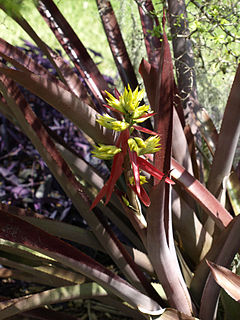
Aechmea nudicaulis is a bromeliad species in the genus Aechmea, which is often used as an ornamental plant. This species is native to Central America, the West Indies, central and southern Mexico, and northern and central South America.

Aechmea calyculata is a species of flowering plant in the Bromeliaceae family.
Aechmea alba is a species of plant in the genus Aechmea. This species is endemic to Brazil.

Aechmea azurea is a plant species in the genus Aechmea. This species is endemic to the State of Espírito Santo in eastern Brazil. It is a vulnerable species of the Atlantic rainforest ecosystem
Aechmea caesia is a plant species in the genus Aechmea. This species is endemic to the State of Rio de Janeiro in Brazil.
Aechmea cariocae is a plant species in the genus Aechmea. This species is endemic to Tijuca National Park in Brazil.
Aechmea conifera is a plant species in the genus Aechmea. This species is endemic to the State of Bahia in eastern Brazil.
Aechmea depressa is a plant species in the genus Aechmea. This species is endemic to the State of Bahia in eastern Brazil.
Aechmea digitata is a plant species in the genus Aechmea. This species is endemic to the State of Bahia in eastern Brazil.

Aechmea emmerichiae is a species in the genus Aechmea. This species is endemic to Chapada Diamantina National Park in eastern Brazil.
Aechmea entringeri is a species in the genus Aechmea. This species is endemic to the State of Espírito Santo in eastern Brazil.

Aechmea eurycorymbus is a plant species in the genus Aechmea. This species is endemic to eastern Brazil.

Aechmea flavorosea is a species in the genus Aechmea. This species is endemic to the State of Rio de Janeiro in Brazil.
Aechmea fraudulosa is a plant species in the genus Aechmea. This species is endemic to the State of Bahia in eastern Brazil.
Aechmea glandulosa is a plant species in the genus Aechmea. This species is endemic to the State of Bahia in eastern Brazil.
Aechmea maasii is a species in the genus Aechmea. This species is endemic to Brazil, known from the States of Espírito Santo and Rio de Janeiro.

Aechmea mollis is a plant species in the genus Aechmea. This species is endemic to the State of Bahia in eastern Brazil.

Aechmea victoriana is a plant species in the genus Aechmea.

Aechmea farinosa is a plant species in the genus Aechmea. This species is endemic to the State of Bahia in eastern Brazil.

Aechmea recurvata is a plant species in the genus Aechmea. This species is native to southern Brazil, Paraguay, Uruguay and northern Argentina.









